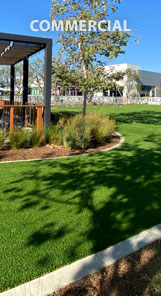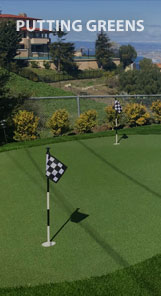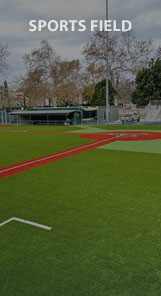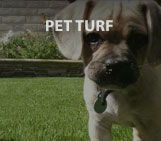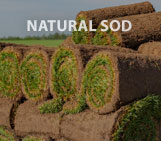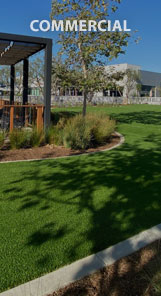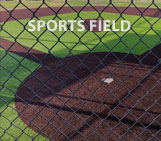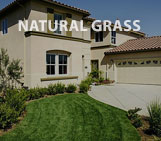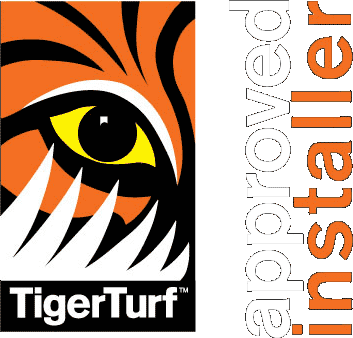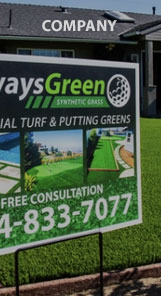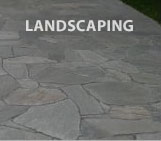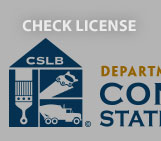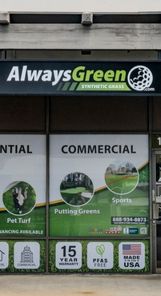Quickly find meanings of terms used in the artificial grass industry.
General Artificial Grass Terms
Certified pitch/field
An on-site built pitch/field which has been tested by an accredited laboratory and verified as meeting the sport’s defined requirements and licensing agreement conditions.
Dimensional stability
Dimensional stability in a synthetic grass product refers to the stability of the primary and secondary backing materials to keep the synthetic grass surfaces from stretching, shrinking or buckling over time.
Disposal of carpet/pad
If it cannot be re-used (e.g. for training venues, nursery schools, playgrounds), it would need to be disposed of in a landfill site.
First Generation Turf
Developed in the 1960’s and 1970’s: Low-profile carpets (8-12mm), high-density fibers.
Irrigation
The application of water to an artificial grass carpet is sometimes done for hockey (to aid ball traction and player sliding).
Key Stage Inspections
Inspection/sign-off of a particular stage of work undertaken at a point when works should cease.
Licensing agreement
The formal agreement entered into by an artificial grass manufacturer and a sport’s governing body concerning the conditions under which approval of artificial grass products for that sport specifically may be granted.
Life-cycle costs
The lifecycle cost of a surface consists of three different costs:
- Initial capital
- Maintenance
- Replacement
Lifespan
The typical period of time that the item lasts before requiring replacement.
Long-pile pitches
Third generation surfaces exceeding 35mm pile height.
MUGAs
Acronym for ‘Multi Use Games Areas’. MUGAs are excellent, versatile surfaces which can be considered where facility requirements demand a number of sports to be played on the surface.
Playing characteristics
The ball/surface and player/surface interaction of a surface system.
Polymer
In synthetics, the basic chemical unit from which fibers are made. It is made of large complex molecules (polymer chains) formed by uniting simple molecules (monomers).
Second Generation Turf
Introduced in the 1980s. Sparser density of fibers, medium pile height (10-35mm), sand-filled.
Surface system
The composite of the individual layers of materials used in the construction of a sports surface – the base, shock pad, artificial grass carpet, and infill.
Texturisation
The processing of yarn, by heat or air pressure, to fix a wavy texture into the yarn and increase its apparent bulk.
Third Generation (3G) Turf
Introduced in the late 1990s – comprising a longer pile (35-65mm), lower density of fibers in-filled with sand and rubber granules.
Product Warranty
A written undertaking by the supplier and/or installer that the product will be fit for its intended purpose for a stated time period from the date of supply or installation, and that any imperfections will be addressed during the period of time that the warranty is valid.
Water-based pitches
An artificial grass pitch which uses water as infill. Most often used for elite and international hockey.
Water Harvesting
Collecting and reusing water that drains from the surface system.
Yarn
A continuous strand of twisted fibers.
Artificial Grass Maintenance Terms
Brooming
Another term for de-fibrillating or brushing-up the blades of grass or to describe the use of a broom to work infill materials into the surface (brooming in the infill – brooming up the turf fibers).
Conditioning surfaces
The removal of any static electricity charge that remains in the artificial grass. This can happen via the application of fabric softener (see Maintenance Section) or through passage of time.
Contamination
This problem occurs from mud and other materials brought from outside the playing area, reducing performance. If the synthetic surface is not fenced there will be a higher potential for contamination from players and spectators walking across the surface (mainly from debris in shoe soles). This will necessitate a high level of maintenance and cleaning to prevent the formation of a drainage inhibiting skin within the surface and the establishment of algae and moss.
Durability
The capacity of the synthetic system to resist degradation by factors such as abrasion, indentation, fatigue, UV, chemicals, fire, staining, delamination and so forth. Durability can vary, depending on the quality of materials used, construction methods, the intensity of use of the pitch, effective maintenance, etc.
Matting
Matting is the usually irreversible adhesion of turf yarn caused by traffic or dirt. Matting can be minimized by exercising the turf with either power brushes or manually raking it back to height.
Powerbroom or brush
A tool used during the construction and grooming of synthetic grass installations. A powerbroom or brush was developed for use with concrete and asphalt sweepers and adopted by the synthetic turf industry as a tool to help defibrillate (or broom) synthetic grass surface materials and help to distribute infill materials across the surfaces.
Shedding
New turf appears to shed some fibers after installation. Many of these blades are cut away during normal installation and hidden during job site cleaning. They work their way to the surface during use. Regular blowing and grooming will resolve this problem.
Static electricity
Cold and low humidity often create isolated motionless charges of electricity, and some turf products can provide static resistance.
Artificial Grass Installation Terms
Crumb rubber
Granules of new or recycled rubber materials used for infill or for top dressing on synthetic grass materials. Granules are specified as either new or recycled rubber, and are sized by the smallest and largest average radius of the granules contained in the packaging. Size of granules used will depend upon the application; golf putting green surfaces require smaller grain size than larger field areas. Typical range is 0.5 – 2.5mm.
Crush recovery (also called ‘Fiber Resilience’)
Crush recovery describes the ability of the synthetic grass fibers to rebound back upright after being walked on, or after having dead weight from furniture (such as moveable goal posts) or other elements. To encourage good recovery, all synthetic grass surfaces made for lawn and landscaping will benefit from some amount of infill materials that provide horizontal and vertical stability as well as UV protection for blades and backing.
Dressed (hybrid) pitches
Pitches using a carpet of woven, tufted or knitted synthetic yarn partly supported or stabilized by the addition of filling material (e.g. sand and/or rubber granules – generally filled to around 60% of the pile height and therefore sometimes referred to as a sand-dressed pitch). Usually 16-20mm pile, crimped down to a playing height of 12-13mm and generally used in relation to hockey surface systems.
Filled pitches
Pitches using a carpet of woven, tufted or knitted synthetic yarn fully supported or stabilized by the addition of filling material (e.g. sand and/or rubber granules).
Granulated rubber
Rubber materials that have been processed into small grains of rubber for use in a variety of finished goods including synthetic grass infill materials. See Crumb Rubber.
Infill
The infill is generally silica sand, rubber granules, or a combination of both, and its function is to support the pile of the carpet, help the pile to remain vertical and contribute to the playing and cushioning qualities of the surface (ball rebound, shock absorption and vertical deformation). Some infill systems use stratified and segregated layers of rubber and sand granules, and others a mixture of sand and rubber. Some new granular rubber infill products may be useful in Australia in reducing radiated heat.
Installation
The installation of a complete synthetic surface system, including the construction of a fully-designed base/drainage system, will take about 16 weeks (two to four weeks for earthworks, six to eight weeks for base works, two weeks for a shock pad and two to three weeks for the carpet and infill). Fencing and floodlight installation can overlap with these phases.
Rubber granule infill
Used as a shock-absorption layer within the carpet, to help the carpet fibers to maintain an upright position, and as a contributor to the desired surface playing characteristics (bounce, traction, etc.).
Rubber (SBR)
SBR is manufactured from recycled tires and other rubber products. It has been used as a major component in turf infill systems, resurfacing of sports activity areas, parks, field and track surfaces, horse tracks and a variety of other coatings and formed rubber products such as mats, bumpers and flooring products for restaurants, day-care centers and the hospitality industry.
Seams/ seaming
The line formed where two pieces of turf are joined. The action of setting the turf and seaming using one or more methods; adhesives, sewing or tacks.
Shrink (See also ‘dimensional stability’)
Synthetic grass surface materials, like most woven products, can shrink or shift under certain conditions. Where temperature variances can change from extreme cold to extreme heat, synthetic grass surfaces can expand and contract. A minor amount of shrink can also occur on surfaces as they age. Shifting of turf surfaces is more often noticed and can be misidentified as shrink.
Shock pad
If required, a shock-absorbing layer is placed over the base, directly under the carpet. It is used to provide a degree of comfort to players underfoot, but also to reduce peak forces for head impacts, and to create defined playing characteristics for specific sports. The two main installation methods of shock pads are:
In-situ: hot mix of rubber shreds/crumbs bound with polyurethane and laid using a small highway type paving machine.
Pre-formed: supplied in rolls and fixed in place by gluing.
A shock pad will significantly increase the cost of installing a synthetic surface but may last for several surface replacements (two to three surfaces – 20 years).
Stability
Horizontal (left to right and reversed) and vertical (up to down and reversed) stability is important to a synthetic grass installation. Turf materials, their backings, the base and sub-base construction of the job all relate to standards of horizontal and vertical stability. A project’s sub-base and base construction should maximize horizontal stability to carry weight load. Synthetic grass primary and secondary backing materials aid the turf system’s surface materials by providing additional horizontal stability and providing the required stability needed to suit the project objectives. To achieve vertical stability, synthetic turf systems are helped by the use of infill materials to stand blades upright and provide resilience and cushion underfoot.
Tape
Seaming tapes or backing are materials used under the edges of two pieces of synthetic grass which will be used as a part of a seaming system to attach the two pieces of synthetic grass together.
Unfilled pitches
Pitches using a carpet of woven, tufted or knitted synthetic yarn in which the density of the pile is sufficient to maintain yarn vertically without support or stabilization by other materials. Usually 10-13mm pile height. May be stitched seams, or fully adhered to the shock pad beneath, and usually needs to be wet to achieve playability.
Artificial Grass Manufacturing Terms
Carpet (artificial grass)
Manufactured from a polymer yarn, artificial grass carpets are either tufted or needle-punched. Third generation carpets are almost always ‘tufted’ carpets. With tufted carpets the pile is formed by looping yarn through a backing material and cutting it to the required length (usually between 35mm and 65mm). The underside of the backing material is coated with latex or polyurethane, which helps hold the tufts in place and provides structural stability to the carpet. Holes are pierced through the backing to assist with drainage where vertical drainage is desired. Carpets can vary in terms of the type of yarn used and density (stitching rate). Most carpets use a single form of yarn while some might use a mixture. The yarn is generally made from either polyethylene (PE), which is soft and less abrasive, or from polypropylene (PP), which is stronger and is often used for low impact sports such as tennis, generally the denser the carpet, the more durable the product.
Delamination
Separation of the secondary backing or attached cushion from the primary backing of the artificial turf.
Degrade, Degradation
Loss of physical property or performance. The ‘weaking out’ or weakening of a system or substance, i.e. ‘The effectiveness of UV protection, the strength of fibers, backing and the porosity of a surface might degrade during the life of the turf.’
Dimensional stability
Refers to the ability of the finished turf surfaces to retain their original size and shape, and resist lateral movement caused by cyclic temperature changes or movement pressure (participants/ traffic).
Fabric
Materials used under and throughout the construction of a synthetic grass project. Woven and non-woven, commercial grade materials provide additional horizontal and vertical stability to the installation.
Face
Also known as the nap or the pile of the surfaces of turf. It describes the total visible surface of the finished turf materials.
Face weight
Refers to the weight of the yarn that is visible above the carpet backing.
Fiber material
Yarn fibers can be manufactured from various natural and synthetic materials. Synthetic grasses and artificial turf are typically made from one or a combination of two or more of the following fiber materials; nylon, polypropylene or polyethylene.
Fiber size/shape
The cross-sectional area and shape of individual ribbons of fiber vary considerably from product to product. The unit of measurement for the weight of the fiber is dtex (1 dtex = gram weight per 1 metre of yarn, using a 10,000 metre average). The shape of the fibers can vary from fibrillated flat ribbon yarns to highly-varied shapes of monofilament yarns. The quantity of yarn used to form the pile will have a significant effect on the cost, performance and durability of the carpet. This is measured as face weight. It will also have a significant impact on the stability of the infill medium in a carpet, and the ‘crushability’ (or fiber resilience) of new ‘shaped’ fibers.
Fiber width
The width of the fiber is measured across its face and can affect the color, shine, vertical recovery and durability of the fibers under extreme conditions; especially field applications.
Fibrillated pile/yarn
Yarn ribbon which is cut from a sheet and is then split or slotted to a variable pattern before twisting into a yarn strand. Designed to influence performance. Has a lattice structure when help open.
Filament
A single, continuous strand of synthetic fibre.
Knit-de-Knit (KDK)
After initial production, the yarn is then knitted into socks and heat-set. This process gives the finished yarn a curly appearance. The purpose of Knit-de-Knit yarn is to reduce the impact of fiber direction in the grass surface. Pile nap (lean) is overcome with KDK yarns.
Latex
Latex is a natural product used as a secondary backing material to lock stitches in place and provide additional dimensional stability.
Monofilament yarn
Individual strips of yarn which are cut from a sheet and twisted or wrapped together to form a yarn strand.
Needle punched carpet
Carpet where the fiber in the pile forms both the pile structure and the majority of the backing cloth. The fibers are needled into a flat primary cloth, and then secondary needled to pull through/angle the fiber to a felt-like structure of the desired quality/configuration of pile.
Non directional yarn
Yarn can be crimped (twisted) so that it does not end up leaning one way and therefore influencing the direction of a moving ball.
Perforations
Perforations define the holes drilled or heat punched into the backing of some synthetic turf materials. The perforations provide a passage for surface water flow through the impermeable carpet backing into the structure beneath.
Permeability
The ability of a material to allow water to pass through. Determined by percolation (infiltration) tests.
Pile
The full depth of tufts or loops of yarn which form the carpet.
Pile crush
Loss of pile thickness by compression (matting) and bending of tufts caused by high traffic or heavy weight. Grooming turf surfaces will often lift the pile back to original height. All turf will crush to some degree during its lifespan.
Pile density
Determined by multiplying the number of tufts per unit area by the unit weight of each tuft.
Pile length
The length of the extended tufts measured from the primary backing top surface to their tips. Pile tuft should be gently extended but not stretched during this measurement.
Polyethylene
Polyethylene or polythene or polymethylene is the most widely used plastic, with an annual production of approximately 80 million metric tons. Its primary use is in packaging (notably the plastic shopping bag).
Polypropylene
Synthetic, thermoplastic polymer used for moulded items, sheets, films and fibers. The polymer is made by stereo specific polymerization of propylene. Most polypropylene turf fibers are solution dyed and sometimes contain ultraviolet stabilisers for outdoor use. The turf fiber is available as both bulked continuous filament yarns and staple for spun yarn production. Slit-film polypropylene is used on woven turf backing.
Polyurethane
A binder (used in shock pads also) used as a secondary backing on synthetic grass materials. Applied as a viscous coating, the polyurethane is sprayed across the surface to help lock-in fiber stitches and increase the horizontal stability of the synthetic grass materials. The secondary backing process is one of the last in the link of steps to producing finished synthetic grass.
Primary backing
The material into, or onto, which the yarn is attached to form the carpet.
Resilience
The capability of the turf to bounce back to its original characteristics after being used. How well a turf can handle high traffic or compressive force is determined by several factors; resilience of fibers and yarn materials, denier (dtex) and infill system of the turf system.
Secondary backing
The material used to coat the back of the carpet after the yarn has been attached to the primary backing.
Tensile Strength
The resistance of a material to a load applied in tension (as opposed to compression).
Texturised yarn
The term given to yarn which has a crimp (see crimping). This crimp is made by texturing the yarn in a special machine, using heat, rather than knitting the yarn. The finished product has a different appearance and performance when compared with products made from Knit-de-Knit yarns. Texturised yarns help prevent pile ‘nap’ (where the pile falls in one direction) but do not fully overcome it.
Twist
Twist is the winding of the yarn around itself; with certain types of yarn this can improve the tufting process.
Construction Terms
Camber
Another word for slope or gradient. Designed into the field to encourage horizontal drainage.
E Layer
Meaning varies internationally but generally refers to an engineered base that has a mixture of resilient particles and granular material that forms a more deformable resilient structural platform for artificial grass surfaces.
Base Fill
Either bound or unbound, placed on the sub-grade/sub-base to influence the engineering and playing characteristics of the whole construction. Provides the camber for the pitch and therefore the surface drainage characteristics.
Base materials
Imported job materials that will be used to construct the foundation over the existing sub-grade (native soils or other surfaces) or sub-base. Base materials may be comprised of, but not limited to the use of, crushed, clean gravel, mine rock and fines, compactable aggregates and road base.
Bill of Quantities
Is a construction industry tendering document which should detail the terms and conditions of the construction or repair contract and itemizes all work to enable a contractor to price the work for which they are bidding.
Binder In-situ rubber shock pads
Are made from a mixture of black Styrene Butadiene Rubber (SBR) granules (2-6mm in size) and a polyurethane binder. Bound base Fill (inclusive of a binding agent) is placed on the sub-base to produce one or more cohesive layers, often then sealed with a bituminous layer.
Clay soils
An earthy fine-grained soil that can retain moisture, and when moist can almost be the consistency of putty, i.e. workable in the hand. When dry, clay soils are notably dusty, hard and unworkable. Devoid of any organic materials, clay-rich soils generally drain slowly, if at all. When saturated, clay-rich soil surfaces can easily deform and rut, particularly under heavy weight loads.
Compaction
The act of compressing the surface materials to reduce air content, decrease percolation and increase density and hence surface stability. Also refers to the common observation on sand in filled carpets over time where maintenance/rejuvenation of the sand layer is not carried out effectively – making the surface hard and unforgiving.
Cut to fill
The act of cutting material from the high side of a slope and placing it in compacted layers at the low side to create a level platform.
Drainage falls
Where a specific slope is designed into a sports surface so surface water will drain away from the playing area.
Fines
Very small particles of matter (sand, soil, etc.). Not used where porosity is important (may clog vertical drainage).
Foundation
Comprises of the layers beneath the shock pad and carpet – the asphalt, base, sub-base and sub-grade.
Geotechnical report
A report on the ground conditions prepared by an appropriately qualified geotechnical engineer. This will ideally report such factors that could affect the construction of a pitch, such as subgrade state, drainage capacity, compaction, moisture levels, and the potential for the ground to swell or shrink as moisture levels change.
Geotextile
Material used to support, separate, filter. Used to strengthen compacted ground, provide a filter barrier around drains, etc.
Macadam
Another name for asphalt. See Asphalt.
Porous/ Porosity
Porosity is a measure of void space in a material. Note: Not to be confused with permeability which is a measure of the ability of the material (such as rocks) to transmit fluid.
Reactive soil (also called ‘high plasticity’)
The property of soil that causes it to swell when moisture content increases and shrinks when moisture content reduces. The resulting ground movement may cause damage to a poorly designed surface.
Soft spots
Areas of ground that have lower than typical strength. Typically, these could be areas where tree roots have been removed and insufficient attention has been paid to compaction when the holes were filled. Soft spots may also be caused by moisture collecting in fine grained clay and silt soils.
Spoon drains
Surface drains (generally around or at the end of the sports surface) designed to collect water and direct that water to collection points.
Slip resistance/ traction
Measures of a finished surface related to sufficient grip underfoot to accelerate and decelerate, adequate slip to turn, etc.
Sub-base
A secondary layer of bound or unbound fill placed on the subgrade to influence the engineering and playing characteristics of the whole construction. Is in addition to the base course, added where the sub-grade conditions are inconsistent.
Sub-grade
The prepared surface of the natural ground onto which the base pavement and carpet system are laid. Provides the ultimate support and sometimes the required surface profile to the base. The strength and stability of the sub-grade are particularly critical for pitches/fields/courts/greens built over filled sites.



